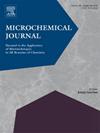Portable cell imprinted polymer-based microfluidic sensor for bacteria detection in real water
IF 4.9
2区 化学
Q1 CHEMISTRY, ANALYTICAL
引用次数: 0
Abstract
Cell-imprinted polymer (CIP) based optical biosensors have transformed point-of-care detection. However, challenges remain in their portability and detection sensitivity, time, and cost. Herein, we present an imprinted polymer-based low-cost microfluidic device integrated into a portable enclosure that enables rapid and sensitive bacteria detection in real water. A portable 3D-printed platform was custom-designed, housing all essential detection components, i.e., pumping and fluorescent imaging units and the microfluidic sensor. CIP coated magnetic microparticles (MPs) with affinity to bacteria were manipulated inside the magnetophoretic microfluidic device at an optimized flow rate of 0.01 mL/min for bacteria capturing. Fluorescent imaging pre- and post-bacteria capture facilitated quantification of fluorescence intensity changes as bacteria were trapped by the CIP-MPs. The sensor’s dose–response curve established limits of detection (LOD) and quantification (LOQ) at 8 × 10 and 6 × 10 CFU/mL, respectively, within a dynamic range of 10 to 10 CFU/mL. It specifically detected , distinguishing it from non-specific bacteria like and . In real pond water tests, our sensor detected 2 × 10⁶ CFU/mL, matching a central lab’s result of 2.33 × 10⁶ CFU/mL, demonstrating its effectiveness for real-water monitoring. While further enhancements are needed for improving the specificity in complex environmental matrices and broader bacterial strain detection, the sensor’s simplicity and portability highlight its potential for practical potential.基于细胞印迹聚合物的便携式微流控传感器,用于检测真实水中的细菌
基于细胞压印聚合物(CIP)的光学生物传感器改变了护理点检测。然而,在便携性、检测灵敏度、时间和成本方面仍存在挑战。在本文中,我们介绍了一种基于压印聚合物的低成本微流控装置,该装置集成在一个便携式外壳中,可在真实水中实现快速、灵敏的细菌检测。我们定制设计了一个便携式 3D 打印平台,容纳了所有重要的检测组件,即泵和荧光成像装置以及微流体传感器。对细菌具有亲和力的 CIP 涂层磁性微颗粒(MPs)在磁流体微流体装置内以 0.01 mL/min 的优化流速进行操作,以捕获细菌。细菌捕获前后的荧光成像有助于量化细菌被 CIP-MPs 捕获时的荧光强度变化。传感器的剂量-反应曲线确定了在 10 到 10 CFU/mL 的动态范围内,检测限(LOD)和定量限(LOQ)分别为 8 × 10 和 6 × 10 CFU/mL。在实际池塘水测试中,我们的传感器检测到了 2 × 10⁶ CFU/mL,与中央实验室检测到的 2.33 × 10⁶ CFU/mL 相匹配,证明了其在实际水监测中的有效性。虽然还需要进一步改进,以提高在复杂环境基质中的特异性和更广泛的细菌菌株检测,但传感器的简易性和便携性突显了它的实用潜力。
本文章由计算机程序翻译,如有差异,请以英文原文为准。
求助全文
约1分钟内获得全文
求助全文
来源期刊

Microchemical Journal
化学-分析化学
CiteScore
8.70
自引率
8.30%
发文量
1131
审稿时长
1.9 months
期刊介绍:
The Microchemical Journal is a peer reviewed journal devoted to all aspects and phases of analytical chemistry and chemical analysis. The Microchemical Journal publishes articles which are at the forefront of modern analytical chemistry and cover innovations in the techniques to the finest possible limits. This includes fundamental aspects, instrumentation, new developments, innovative and novel methods and applications including environmental and clinical field.
Traditional classical analytical methods such as spectrophotometry and titrimetry as well as established instrumentation methods such as flame and graphite furnace atomic absorption spectrometry, gas chromatography, and modified glassy or carbon electrode electrochemical methods will be considered, provided they show significant improvements and novelty compared to the established methods.
文献相关原料
| 公司名称 | 产品信息 | 采购帮参考价格 |
|---|
 求助内容:
求助内容: 应助结果提醒方式:
应助结果提醒方式:


